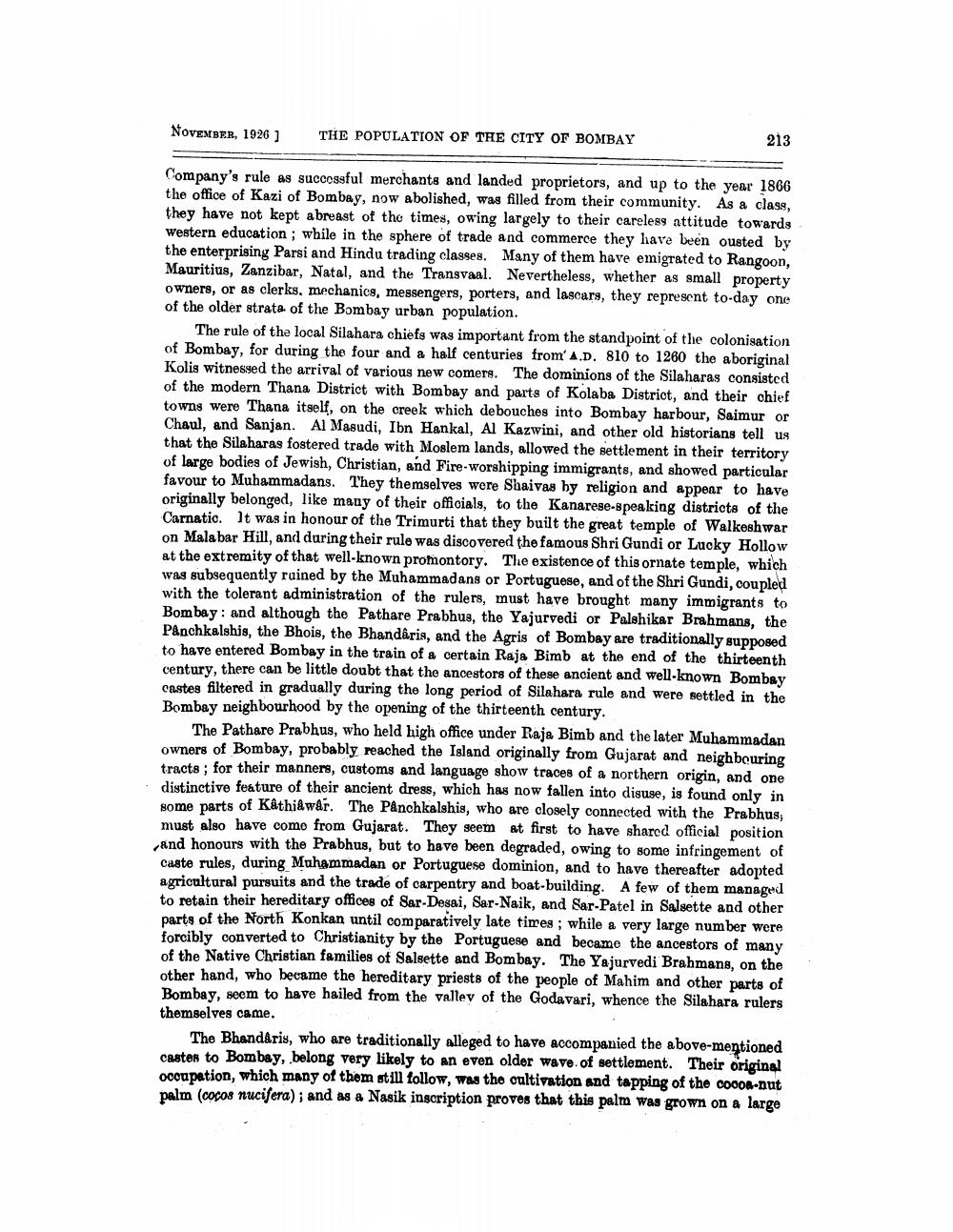________________
NOVEMBER, 1926 ]
THE POPULATION OF THE CITY OF BOMBAY
213
Company's rule as succossful merchants and landed proprietors, and up to the year 1866 the office of Kazi of Bombay, now abolished, was filled from their community. As a class, they have not kept abreast of the times, owing largely to their careless attitude towards Western education; while in the sphere of trade and commerce they have been ousted by the enterprising Parsi and Hindu trading classes. Many of them have emigrated to Rangoon, Mauritius, Zanzibar, Natal, and the Transvaal. Nevertheless, whether as small property owners, or as clerks, mechanics, messengers, porters, and lascars, they represent to-day one of the older strata of the Bombay urban population.
The rule of the local Silahara chiefs was important from the standpoint of the colonisation of Bombay, for during the four and a half centuries from A.D. 810 to 1260 the aboriginal Kolis witnessed the arrival of various new comers. The dominions of the Silaharas consisted of the modern Thana District with Bombay and parts of Kolaba District, and their chief towns were Thana itself, on the creek which debouches into Bombay harbour, Saimur or Chaul, and Sanjan. Al Masudi, Ibn Hankal, Al Kazwini, and other old historians tell us that the Silaharas fostered trade with Moslem lands, allowed the settlement in their territory of large bodies of Jewish, Christian, and Fire-worshipping immigrants, and showed particular favour to Muhammadans. They themselves were Shaivas hy religion and appenr to have originally belonged, like many of their officials, to the Kanarese-speaking districts of the Carnatic. It was in honour of the Trimurti that they built the great temple of Walkeshwar on Malabar Hill, and during their rule was discovered the famous Shri Gundi or Lucky Hollow at the extremity of that well-known promontory. The existence of this ornate temple, which was subsequently ruined by the Muhammadans or Portuguese, and of the Shri Gundi, coupled with the tolerant administration of the rulers, must have brought many immigrants to Bombay: and although the Pathare Prabhus, the Yajurvedi or Palshikar Brahmans, the Panchkalshis, the Bhois, the Bhandaris, and the Agris of Bombay are traditionally supposed to have entered Bombay in the train of a certain Raja Bimb at the end of the thirteenth century, there can be little doubt that the ancestors of these ancient and well-known Bombay castes filtered in gradually during the long period of Silahara rule and were settled in the Bombay neighbourhood by the opening of the thirteenth century.
The Pathare Prabhus, who held high office under Raja Bimb and the later Muhammadan owners of Bombay, probably reached the Island originally from Gujarat and neighbouring tracts; for their manners, customs and language show traces of a northern origin, and one distinctive feature of their ancient dress, which has now fallen into disuse, is found only in some parts of KathiAwar. The Panchkalshis, who are closely connected with the Prabhus, must also have come from Gujarat. They seem at first to have shared official position and honours with the Prabhus, but to have been degraded, owing to some infringement of caste rules, during Muhammadan or Portuguese dominion, and to have thereafter adopted agricultural pursuits and the trade of carpentry and boat-building. A few of them managed to retain their hereditary offices of Sar-Desai, Sar-Naik, and Sar-Patel in Salsette and other parts of the North Konkan until comparatively late times; while a very large number were forcibly converted to Christianity by the Portuguese and became the ancestors of many of the Native Christian families of Salsette and Bombay. The Yajurvedi Brahmans, on the other hand, who became the hereditary priests of the people of Mahim and other parts of Bombay, seem to have hailed from the valley of the Godavari, whence the Silahara rulers themselves came.
The Bhandaris, who are traditionally alleged to have accompanied the above-mentioned castes to Bombay, belong very likely to an even older wave of settlement. Their original occupation, which many of them still follow, was the cultivation and tapping of the coooh-nut palm cocos nucifera); and as a Nasik inscription proves that this palm was grown on a large




